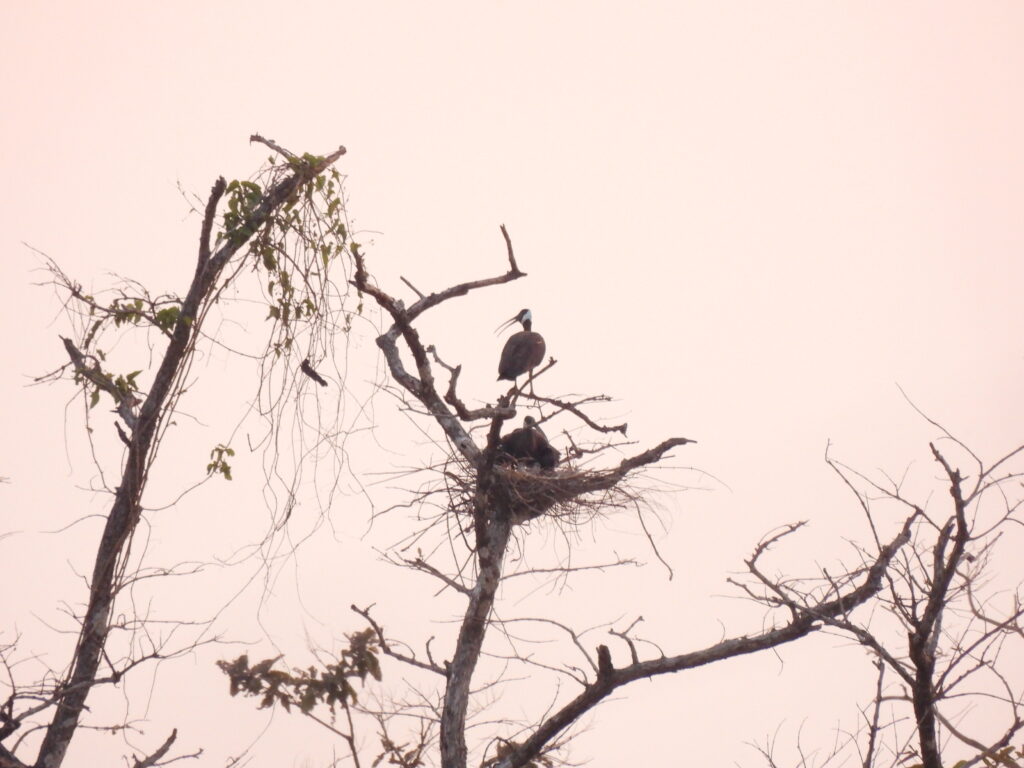How empowerment and capacity-building of local communities is vital to the long-term strategy to conserve Critically Endangered White-shouldered Ibis in the Lomphat Landscape.

White-shouldered Ibis at home in their nests near to the Sre Chrey Village
The White-shouldered Ibis Pseudibis davisoni was once widely distributed across South-East Asia, but, due mainly to the loss of Dry Deciduous Forest habitats, declined severely throughout the 20th century. Today it is almost exclusively confined to the dry forests of Northern and Eastern Cambodia, with potentially one very small population still existing on the island of Borneo. While sharing largely similar distribution to another related and also Critically Endangered species, the Giant Ibis, the White-shouldered Ibis differs ecologically as it appears heavily dependent on low-intensity, traditional agriculture land-use within the dry forest landscapes. This dependence means that it is most often found in the vicinity of rural villages, and therefore it’s survival is inextricably linked with communities and sustainable local practices. One area where White-shouldered Ibis have been holding on to healthy breeding populations is near the southern boundary of Lomphat Wildlife Sanctuary around the village of Sre Chrey, in the Nang Khi Loek Commune of Mondulkiri Province.
In 2019, the Ministry of Environment and NatureLife Cambodia formed an agreement to develop a REDD+ Project in Lomphat Wildlife Sanctuary, and in 2022 NatureLife Cambodia secured the support USAID Morodok Baitang to begin implementing the project, including the biodiversity conservation long-term strategies. Mr Jeudi Say, the NatureLife Cambodia Senior REDD+ Coordinator recently spoke to many key local stakeholders in the Sre Chrey Village area, to find out how White-shouldered Ibis conservation was being achieved, the initial challenges that needed to be overcome, and the outlook for the future.
The village of Sre Chrey was until recently an isolated and remote location, and has a diverse ethnic mix of people, 37% of which are formed of a variety of Indigenous groups, including Stieng, Tompuonn, Charay, Bunong, and Kroal ethnicities. Since 2010, a new road was built, National Highway 76. The road passes relatively close to the Sre Chrey Village, and while dramatically improving the villages connection to the transport network, ushered in a new era of pressure on the forest and biodiversity. Previously tasked with the sustainable use of natural resources, law enforcement of PA laws became increasingly disconnected from the local community, and the problems often associated with PA enforcement surfaced.
Remembering the situation, the Sre Chrey Village Vice-Chief Mr Bunsorn Jouch, and Commune Council Mr Pov Munny, explained “the enforcement of forest crimes suffered from a lack of collaboration among the competent authorities, and the area was not well managed. It would often happen that the wrong doers would conspire, and it would end up that people who did not commit the crimes would be arrested. There was a lot of misunderstandings”. These misunderstanding resulted in significant friction between the community and PA authorities.
To turn the situation around, the community requested the assistance of the leading conservation NGO in Lomphat, NatureLife Cambodia to set up a formal community-run group to better manage the natural resources. Initially, the plan was to form a Community Protected Area, but this could not be fulfilled due to administrative legacy issues regarding the status of the village at District and Provincial levels. Undeterred, a Community-Based Organisation (CBO) was formed instead: the Sre Chrey Biodiversity Conservation Group (SBCG). Officially formed in 2017, the group is able to perform almost all of the functions of a CPA, and is designated to cover an area of around 2760 hectares. The main objectives of the SBCG are to monitor endanger species and protect biodiversity and natural resources.
Speaking in 2023, the current SBCG team leader, Mr Nhoeng Seng described the initial situation “the challenges have been that the perpetrators usually commit crimes such as poaching, logging or land clearance during the night. This has been very challenging for the SBCG team. Additionally, at the beginning the home-made guns were often used by the perpetrators against the group’s patrol teams.”

Figure 1: A Round-table meeting with Mr Nhoeng Seng and the leaders of the Sre Chrey Biodiversity Conservation Group
One aspect of the formation of this official group has been the platform and channel to communicate and collaborate directly with PA Law Enforcement teams, which were also overhauled and improved in LWS in 2017. Part of this has been the ability to clearly disseminate information about the PA laws to the community. Mr. Chakk In, MoE Ranger at Sre Chrey Sub-station observed that “for rangers who enforce the protected area law, it’s very difficult when the villagers do not know or understand the laws”. Mr Chakk was speaking from his experience working at the Ranger Sub-station Post, which was originally placed within the actual village of Sre Chrey around 2013, but to improve operation was moved to its current location, around 8 Km from the Sre Chrey Village in 2021. Also supported by NLC, the four Rangers permanently stationed there have been able to improve the alignment with the local community. Mr. Chakk In said that “the rangers have built good collaboration with local authorities and SBCG. The rangers have been reported about the serious crimes by the SBCG, village and commune authorities. This good collaboration has made them effectively enforce the law and intervene on time.”

Figure 2: Mr Chakk In, of the MoE Ranger Station at Sre Chrey talks to Mr Jeudi Say, NatureLife Cambodia, Senior REDD+ Coordinator
The community themselves also have recognised this improvement in connectedness and relationship, not just with the Rangers, but many key stakeholder groups. On behalf of the commune council, Mr Pov Munny said since early 2022, he has tried his best to enhance collaboration between the villagers, the village authorities, and the Provincial Department of Environment, including holding monthly meetings, adding “the Village, Commune, SBCG group, and Rangers now have built good communications together, contacting and reporting to each other”. Key issues frequently addressed are collaboration in patrolling to prevent illegal forest encroachment, and by educating offenders to dissuade them from committing future crimes.

Figure 3: Sre Chrey Village Vice-Chief Mr Bunsorn Jouch, and Commune Council Mr Pov Munny, explain the past challenges, current progress and future hopes for the area
With this collaboration, Mr Nhoeng Seng, the SBCG group leader, hopes that the biodiversity can increase the forests preserved. Speaking about the group’s desire to see the development of the group through the support of the LWS REDD+ Project, he says he hopes that Sre Chrey can become the role model for other villages in the REDD+ project area. “The key to the good collaboration so far has been maintaining the constructive dialogue”, he added. Currently, there are six people including team leader, that make up the voluntary patrol group of the SBCG.
Today, it is possible to visit White-shouldered Ibis nests, with the birds sitting unperturbed and unmolested just a short walk from the village, and the community are keen to develop tourism opportunities for keen bird-watchers. Without local willpower, this type of close coexistence of people and wildlife is impossible, but Sre Chrey and the SBCG has proven what communities can achieve when local stakeholders are aligned and working in the same direction, towards the same goals.
Tagged:



